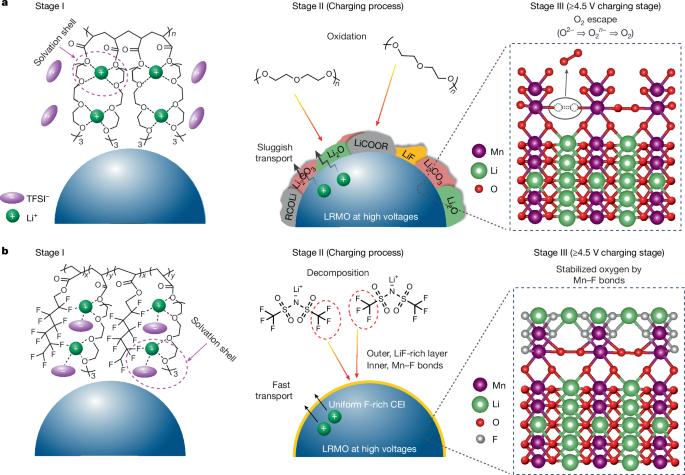Tailoring polymer electrolyte solvation for 600 Wh kg−1 lithium batteries
IF 48.5
1区 综合性期刊
Q1 MULTIDISCIPLINARY SCIENCES
引用次数: 0
Abstract
Polymer electrolytes paired with lithium-rich manganese-based layered oxide (LRMO) cathodes and anode-free cell design are considered one of the most promising high-energy-density and high-safety systems1–4. However, the unstable anode morphological changes and the irreversible anionic reactions at the electrolyte–cathode interfaces induce oxygen escape and catalytic decomposition of polymer electrolytes, resulting in severe interfacial degradation and poor cycling stability. Here we design an in-built fluoropolyether-based polymer electrolyte composed of strongly solvating polyether and weakly solvating fluorohydrocarbon pendants, creating an anion-rich solvation structure and thus anion-derived fluorine-rich interfacial layers on the cathode and anode to resist interfacial issues. The LRMO cathode exhibits improved oxygen redox reversibility with substantially reduced oxygen-involving interfacial side reactions. This quasi-solid-state polymer electrolyte with 30 wt% trimethyl phosphate enables an LRMO cathode with a reversible high-areal-capacity cycling (>8 mAh cm−2) in pouch cells and long-term stability (>500 cycles at 25 °C) in coin cells, respectively. The pouch cells exhibit an energy density of 604 Wh kg−1 (1,027 Wh l−1) and excellent safety under a nail penetration at a fully charged condition. Our work, therefore, provides a promising direction for creating practical high-energy-density and high-safety lithium batteries. An in-built fluoropolyether-based quasi-solid-state polymer electrolyte enables high-capacity lithium-rich manganese-based layered oxide cathodes with stable interfaces, achieving 604 Wh kg−1 pouch-cell energy density.

为600 Wh kg-1锂电池定制聚合物电解质溶剂。
聚合物电解质与富锂锰基层状氧化物(LRMO)阴极和无阳极电池设计相结合被认为是最有前途的高能量密度和高安全性系统之一1-4。然而,不稳定的阳极形态变化和不可逆的阴离子反应在电解质-阴极界面诱发氧逸出和聚合物电解质的催化分解,导致界面降解严重,循环稳定性差。本文设计了一种内置的含氟聚醚聚合物电解质,由强溶剂化聚醚和弱溶剂化氟烃悬垂组成,形成了富阴离子的溶剂化结构,从而在阴极和阳极上形成了阴离子衍生的富氟界面层,以抵抗界面问题。LRMO阴极表现出更好的氧氧化还原可逆性,显著减少了含氧界面副反应。这种含有30 wt%磷酸三甲基的准固态聚合物电解质使LRMO阴极在袋状电池中具有可逆的高面积容量循环(bbb8 mAh cm-2),在硬币状电池中具有长期稳定性(>500循环,25°C)。在充满电的情况下,袋状电池的能量密度为604 Wh kg-1 (1,027 Wh l-1),并且在钉子穿透下具有出色的安全性。因此,我们的工作为创造实用的高能量密度和高安全性锂电池提供了一个有希望的方向。
本文章由计算机程序翻译,如有差异,请以英文原文为准。
求助全文
约1分钟内获得全文
求助全文
来源期刊

Nature
综合性期刊-综合性期刊
CiteScore
90.00
自引率
1.20%
发文量
3652
审稿时长
3 months
期刊介绍:
Nature is a prestigious international journal that publishes peer-reviewed research in various scientific and technological fields. The selection of articles is based on criteria such as originality, importance, interdisciplinary relevance, timeliness, accessibility, elegance, and surprising conclusions. In addition to showcasing significant scientific advances, Nature delivers rapid, authoritative, insightful news, and interpretation of current and upcoming trends impacting science, scientists, and the broader public. The journal serves a dual purpose: firstly, to promptly share noteworthy scientific advances and foster discussions among scientists, and secondly, to ensure the swift dissemination of scientific results globally, emphasizing their significance for knowledge, culture, and daily life.
 求助内容:
求助内容: 应助结果提醒方式:
应助结果提醒方式:


